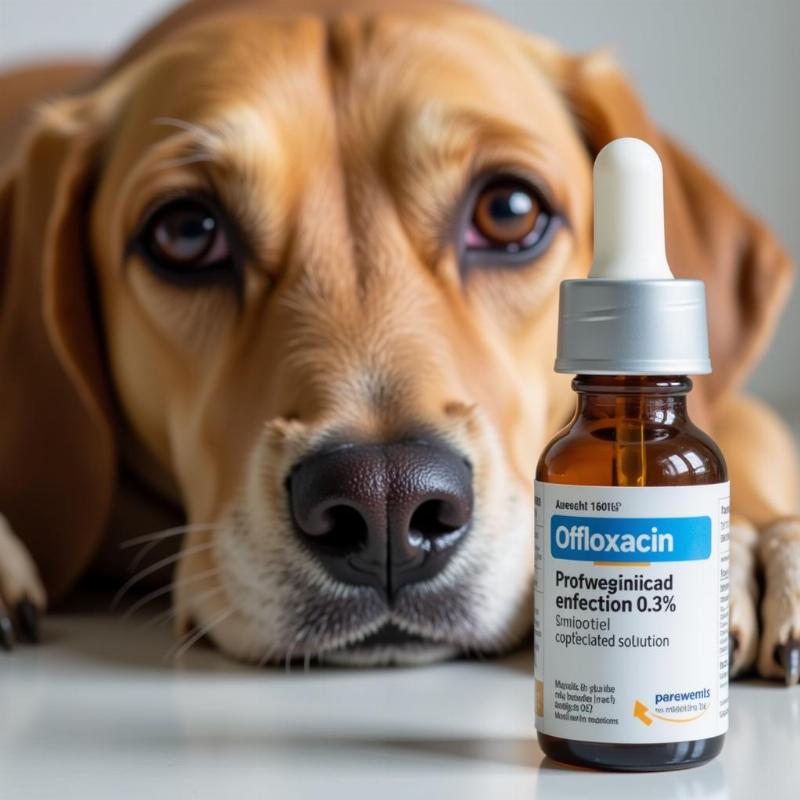Ofloxacin ophthalmic solution 0.3% is a commonly prescribed antibiotic for treating bacterial eye infections in dogs. Understanding its proper use, potential side effects, and when to seek veterinary care is crucial for every responsible dog owner. This guide will equip you with the knowledge to effectively utilize this medication and ensure your furry friend’s ocular health.
Understanding Ofloxacin and Its Uses in Dogs
Ofloxacin belongs to a class of antibiotics called fluoroquinolones. It works by inhibiting bacterial DNA replication, effectively stopping the infection’s spread. Veterinarians prescribe ofloxacin 0.3% ophthalmic solution to treat a range of bacterial eye infections in dogs, including conjunctivitis, corneal ulcers, and blepharitis. It’s essential to remember that ofloxacin is only effective against bacterial infections and not viral or fungal ones. Therefore, a proper diagnosis from a veterinarian is crucial before starting treatment.
 Ofloxacin Eye Drops for Dogs
Ofloxacin Eye Drops for Dogs
Administering Ofloxacin Eye Drops Correctly
Administering eye drops can sometimes be challenging, especially with a wiggly dog. Here’s a step-by-step guide for safe and effective application:
- Wash your hands thoroughly: This prevents the introduction of further bacteria into your dog’s eye.
- Gently restrain your dog: Have someone help you hold your dog securely, or wrap them in a towel for better control.
- Position the bottle: Hold the bottle of ofloxacin ophthalmic solution 0.3% just above your dog’s eye, avoiding contact with the tip of the bottle to prevent contamination.
- Administer the drops: Gently squeeze the prescribed number of drops into the affected eye. Avoid touching the eye with the bottle tip.
- Close the eye: Briefly close your dog’s eye to allow the medication to distribute evenly.
- Reward your dog: Offer a treat or praise to make the experience positive.
Potential Side Effects and Precautions
While ofloxacin is generally safe, some dogs may experience mild side effects such as temporary stinging or redness. These are usually transient and resolve on their own. However, if you notice any unusual symptoms like excessive tearing, swelling, or changes in vision, contact your veterinarian immediately. It is also crucial to complete the entire course of treatment as prescribed, even if the symptoms improve. Stopping the medication prematurely can lead to antibiotic resistance and recurrence of the infection.
“Always finish the prescribed medication, even if your dog’s eye appears better,” advises Dr. Emily Carter, DVM, a veterinary ophthalmologist at Animal Eye Clinic of New York. “Stopping prematurely can lead to a resurgence of the infection and make it harder to treat in the future.”
When to Consult Your Veterinarian
If your dog shows any signs of an eye infection, such as redness, discharge, squinting, or pawing at the eye, it’s crucial to seek veterinary care promptly. Do not attempt to self-treat with over-the-counter medications or home remedies, as this can worsen the condition or mask underlying issues. Only a veterinarian can accurately diagnose the cause of the eye problem and prescribe the appropriate treatment.
Conclusion
Ofloxacin ophthalmic solution 0.3% is a valuable tool in treating bacterial eye infections in dogs. However, proper administration and close monitoring are essential for successful treatment. By following your veterinarian’s instructions and understanding the potential side effects, you can help ensure your dog’s eye health and comfort. Always consult your veterinarian if you have any concerns about your dog’s eyes.
FAQ
- How long does it take for ofloxacin to work in dogs? You should start to see improvement within a few days, but complete the entire prescribed course even if the eye looks better.
- Can I use human ofloxacin eye drops on my dog? No, never use human medications on your dog without consulting your veterinarian. The concentration and formulation may differ and could be harmful to your pet.
- What if I miss a dose? Administer the missed dose as soon as you remember. If it’s close to the next scheduled dose, skip the missed dose and continue with the regular schedule.
- Can ofloxacin be used with other eye medications? Discuss all medications your dog is currently taking with your veterinarian to avoid potential interactions.
- What should I do if my dog’s eye gets worse during treatment? Contact your veterinarian immediately.
- Can ofloxacin cause blindness in dogs? While rare, certain severe allergic reactions can lead to complications. Always consult your vet if you notice any unusual symptoms.
- How should I store ofloxacin eye drops? Store at room temperature, away from direct sunlight and moisture.
Beautdogs.us: Your Trusted Source for Dog Care
Beautdogs.us is your premier online destination for comprehensive and engaging information on dog care, breeds, and lifestyle in the US. We offer expert advice, product reviews, and valuable resources to help you provide the best possible care for your canine companion. Whether you’re a seasoned dog owner or just starting your journey, Beautdogs.us is your trusted source for reliable information. Contact us today for personalized guidance: Email: [email protected], Phone: +1 501-555-7529.